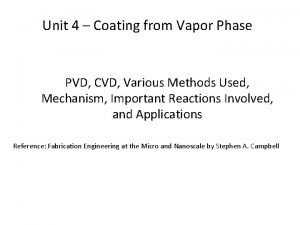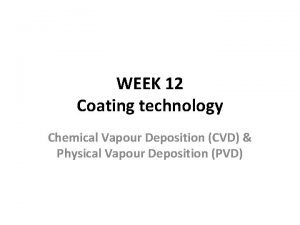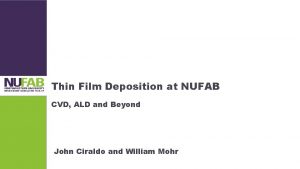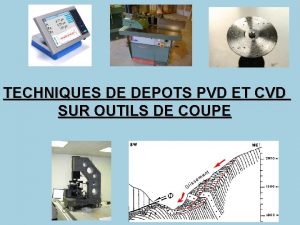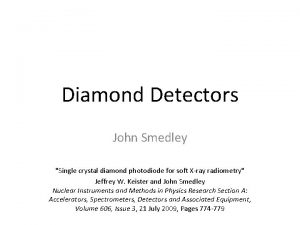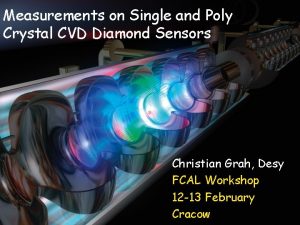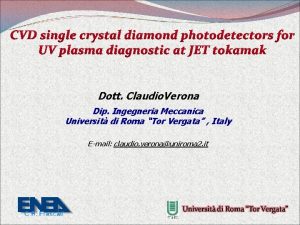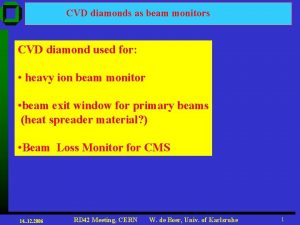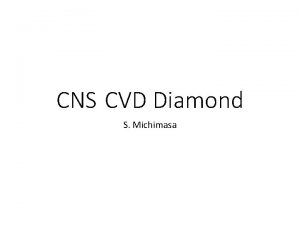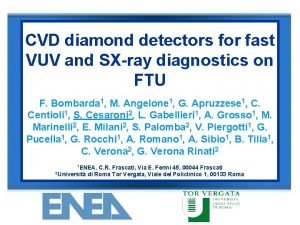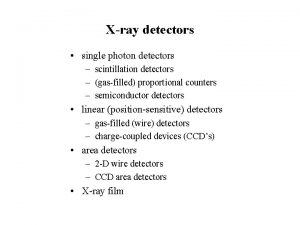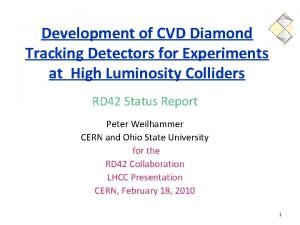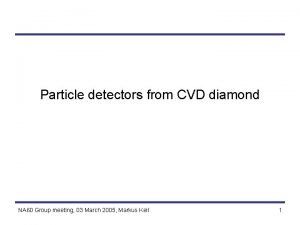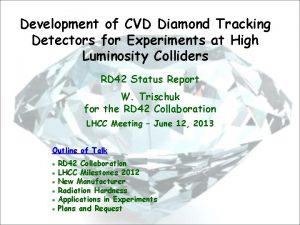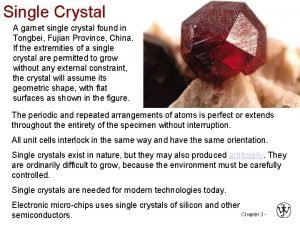CVD single crystal diamond detectors for UV and
















- Slides: 16

CVD single crystal diamond detectors for UV and soft X-Ray plasma diagnostic at JET tokamak Presented by Maurizio Angelone Associazione EURATOM-ENEA sulla Fusione ENEA, C. R. Frascati

Contributors EFDA-JET, Culham, UK Università di Roma “Tor Vergata”, (Italy) S. Almaviva M. Marinelli E. Milani G. Prestopino A. Tucciarone C. Verona G. Verona Rinati I. Coffey, A. Murari Ass. EURATOM/ENEA Frascati, Italy M. Angelone M. Pillon

Outline ü Motivation ü SCD detectors ü Device characterization ü Results at JET ü Conclusions

UV and X diagnostic at JET Plasma diagnostics: most relevant emissions in extreme-UV and soft-X-ray spectral range. Information on: Ø temperature Ø density Ø particle and energy confinement timescale Ø impurities dynamics Ø atomic collision rates Ø plasma-wall interaction Ø plasma dynamics Ø characterization of the electron fluid Ø atomic structure of highly ionized atoms Required features for detectors: ü Radiation hardness ü Low sensitivity to neutrons and -rays ü Fast response ü Visible blind ü Good sensitivity in the EUV/soft-X spectral range

Single Crystal Diamond detector Layered structure produced with two separate steps UV or X-Ray The intrinsic layer is 2 -200 mm thick depending upon the use active area is about 6 mm 2 Al or Pt contact electrode disc-shaped Ag contact CVD intrinsic A CVD B-dopd HPHT substrate ØThe diamond photodetector operated in transversal configuration. ØThe detector can work with no applied bias voltage (photovoltaic regime). ØThe photocurrent is measured between the ptype diamond layer and ground. No signal due to secondary electrons. JET DETECTORS ØThe Al contact is used for UV (100 nm thick). The intrinsic layer was 5 mm thick. Ø For X-rays (Al contact) the intrinsic layer was 22 mm thick

Single Crystal Diamond detector The UV detector has been calibrated in the range 20 - 80 nm using He/Ne gas discharge radiation sources and a toroidal grating monochromator Responsivity to UV Responsivity to X-ray The+ VX-rays detector has been absolute bias calibrated in the range 6 -20 ke. V at the synchrotron facility Diamond Light Source, Harwell (UK) X-ray Transmission

Devices characterization: I-V curve Dark current The dark current is very low The best signal to dark current ratio (SDR) performance is obtained at zero bias voltage Our devices show a photocurrent response even at zero voltage bias, exploiting the internal junction electric field

Devices characterization SCD X-rays - detector SCD UV - detector Temporal Linearity He UV Vbias = 0 Volt

Devices characterization - UV He and He-Ne spectra measured by the SCD detector Ø All spectral lines are clearly observed with high signal to noise ratios, demonstrating the good photodetection capabilities of CVD single crystal diamond in the extreme UV spectral region. Ø The low intensity lines of the He spectrum in the wavelength range 22 – 27 nm are easily resolved.

Measurements at JET Two CVD diamond detectors were permanently installed at JET in KS 6 chamber and connected to the main on-line data acquisition system They are continuously recording the JET shots. The electronic consists in variable-gain low-noise current amplifiers FEMTO model DLPCA-200 and a 10 40 KHz sampling rate ADC VUV and X broadband spectroscopy – direct line of sight of the plasma

Measurements at JET: Results The data acquired at JET have evidenced: fast response time, good signal to noise ratio, insensitivity to background radiation such as neutrons and gammas, good reliability during long lasting operation. Diamond results compared with JET standard UV (microchannel Plates) and X-ray detectors (silicon). The UV detector was used for measuring Edge Localized Modes (ELMs) activity as well as impurities influx during laser blow-off experiments The Soft-X detector seems promising for MHD studies. Improved performances (time resolution) by using a 40 KHz sampling rate ADC

Measurements at JET: Results Neutron (in)sensitivity Shot #75057 Neutrons JET shot acquired by keeping closed the UV entrance shutter

Measurements at JET : UV Shot #74355: Nickel ablation experiment

Measurements at JET – X-ray ZOOM Shot #74663

Conclusions ü CVD single crystal diamond UV and X detectors were permanently installed at Joint European Torus during the 2008 -2009 experimental campaigns and connected to the main on-line data acquisition system. ü The detectors can operate at zero bias voltage and show fast response and good signal to noise ratio. ü First data acquired at JET have evidenced fast response time, good sensitivity, stability and extremely low sensitivity to neutron background. Analysis still in progress ü Some JET research groups are currently using the data produced with diamond photodetectors to study the dynamic of impurities in the plasma as well as the ELMs.

 Pvd
Pvd Pvd vs cvd
Pvd vs cvd Nufab northwestern
Nufab northwestern Pvd
Pvd Commvault port 8403
Commvault port 8403 Where are feature detectors located
Where are feature detectors located Feature detectors ap psychology
Feature detectors ap psychology Feature vectors
Feature vectors Feature detectors
Feature detectors Frontier detectors for frontier physics
Frontier detectors for frontier physics Yodsawalai chodpathumwan
Yodsawalai chodpathumwan Photo detectors
Photo detectors What is streaming potential
What is streaming potential Vhv voltage detectors
Vhv voltage detectors Photo detectors
Photo detectors Nuclear detectors
Nuclear detectors Hplc detector types
Hplc detector types
